Edinburgh, Scotland, UK 作者: 来源: 发布时间:2021-07-29
I. Population and Area
Continent: Europe
Country: The U.K
State/Province: Scotland
City/Town: Edinburgh
Total Area: 101.9 (sq mi)
Population in 2011: 482.0(thousand)
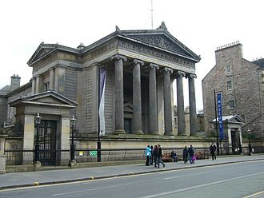
II. Natural Geography (environment and resources)
Cityscape
Situated in Scotland's Central Belt, Edinburgh lies on the Firth of Forth's southern shore. The city centre is 2 1⁄2 miles (4.0 km) southwest of the shoreline of Leith and 26 miles (42 km) inland, as the crow flies, from the east coast of Scotland and the North Sea at Dunbar. While the early burgh grew up near the prominent Castle Rock, the modern city is often said to be built on seven hills, namely Calton Hill, Corstorphine Hill, Craiglockhart Hill, Braid Hill, Blackford Hill, Arthur's Seat and the Castle Rock, giving rise to allusions to the seven hills of Rome.
Areas
Edinburgh includes former towns and villages that retain much of their original character as settlements in existence before they were absorbed into the expanding city of the nineteenth and twentieth centuries. Many areas, such as Dalry, contain residences that are multi-occupancy buildings known as tenements, although the more southern and western parts of the city have traditionally been less built-up with a greater number of detached and semi-detached villas. The historic centre of Edinburgh is divided in two by the broad green swathe of Princes Street Gardens. To the south, the view is dominated by Edinburgh Castle, built high on Castle Rock, and the long sweep of the Old Town descending towards Holyrood Palace. To the north lie Princes Street and the New Town. The West End includes the financial district, with insurance and banking offices as well as the Edinburgh International Conference Centre.
Climate
Like most of Scotland, Edinburgh has a temperate, maritime climate which, despite its northerly latitude, is milder than places which lie at similar latitudes such as Moscow and Labrador.] The city's proximity to the sea mitigates any large variations in temperature or extremes of climate. Winter daytime temperatures rarely fall below freezing while summer temperatures are moderate, rarely exceeding 22 °C (72 °F).
Air
Edinburgh Airport is Scotland's busiest airport and the principal international gateway to the capital, handling over 14.7 million passengers, it was also the sixth-busiest airport in the United Kingdom by total passengers in 2019. In anticipation of rising passenger numbers, the former operator of the airport BAA outlined a draft masterplan in 2011 to provide for the expansion of the airfield and the terminal building. In June 2012, Global Infrastructure Partners purchased the airport for £807 million. The possibility of building a second runway to cope with an increased number of aircraft movements has also been mooted
Bus
Travel in Edinburgh is undertaken predominantly by bus. Lothian Buses, the successor company to Edinburgh Corporation Transport Department, operate the majority of city bus services within the city and to surrounding suburbs, with the most routes running via Princes Street. Services further afield operate from the Edinburgh Bus Station off St Andrew Square and Waterloo Place and are operated mainly by Stagecoach East Scotland, Scottish Citylink, National Express Coaches and Borders Buses.
Rail
Edinburgh Waverley is the second-busiest railway station in Scotland, with only Glasgow Central handling more passengers. On the evidence of passenger entries and exits between April 2015 and March 2016, Edinburgh Waverley is the fifth-busiest station outside London; it is also the UK's second biggest station in terms of the number of platforms and area size. Waverley is the terminus for most trains arriving from London King's Cross and the departure point for many rail services within Scotland operated by Abellio ScotRail.
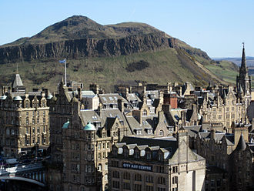
III. Economy
As the centre of Scotland's government and legal system, the public sector plays a central role in Edinburgh's economy. Many departments of the Scottish Government are in the city. Other major employers include NHS Scotland and local government administration. When the £1.3bn Edinburgh & South East Scotland City Region Deal was signed in 2018, the region's Gross Value Added (GVA) contribution to the Scottish economy was cited as £33bn, or 33% of the country's output. But the Deal's partners noted that prosperity was not evenly spread across the city region, citing 22.4% of children living in poverty and a shortage of affordable housing.
Edinburgh has the strongest economy of any city in the United Kingdom outside London and the highest percentage of professionals in the UK with 43% of the population holding a degree-level or professional qualification. According to the Centre for International Competitiveness, it is the most competitive large city in the United Kingdom. It also has the highest gross value added per employee of any city in the UK outside London, measuring £57,594 in 2010. It was named European Best Large City of the Future for Foreign Direct Investment and Best Large City for Foreign Direct Investment Strategy in the Financial Times fDi magazine awards 2012/13.
In the 19th century, Edinburgh's economy was known for banking, publishing and brewing. Today, its economy is based mainly on financial services, scientific research, higher education, and tourism.In March 2010, unemployment in Edinburgh was comparatively low at 3.6%, and it remains consistently below the Scottish average of 4.5%. Edinburgh is the second most visited city by foreign visitors in the UK after London.
Banking has been a mainstay of the Edinburgh economy for over 300 years, since the Bank of Scotland was established by an act of the Scottish Parliament in 1695. Today, the financial services industry, with its particularly strong insurance and investment sectors, and underpinned by Edinburgh-based firms such as Scottish Widows and Standard Life Aberdeen, accounts for the city being the UK's second financial centre after London and Europe's fourth in terms of equity assets. The NatWest Group (formerly Royal Bank of Scotland Group) opened new global headquarters at Gogarburn in the west of the city in October 2005. The city is home to the headquarters of Bank of Scotland, Sainsbury's Bank, Tesco Bank, and TSB Bank.
IV. Industrial Characterisitics
Major industries:
The main industries of Edinburgh include: Agriculture, Banking & Finance, Computing, Construction, Defence, Electronics, Emergency Services, Fishing, Food & Drink, Forestry, Life Sciences, Oil & Gas, Renewable Energy, Shipbuilding, Textiles, Tourism and Transport.
Edinburgh has been a centre of banking for over 300 years, the Bank of Scotland was founded in 1695, by an act of the original Parliament of Scotland, and is now part of the Lloyds Banking Group, who have kept the Scottish headquarters in Edinburgh. The Royal Bank of Scotland also has its global headquarters in Edinburgh. The bank was founded in 1727 by Royal Charter and is now the fifth largest in the world by market capitalisation. In 2000, the Royal Bank of Scotland (RBS) acquired the National Westminster Bank in the biggest banking takeover in British history, to create a huge group with an expanded portfolio and a global outreach.
Major projects and related introductions:
St James to turn Edinburgh into 'prime shopping destination'
Due to open in October 2020, work has restarted on the £1 billion Edinburgh St James development which spans across 1.7 million square ft and will replace the former St James Centre, which closed its doors for the last time in 2016.
While its predecessor had barely any big name brands to boast about, the new St James will be home to the likes of H&M, Zara and Topshop, with room for 85 shops and more than 30 food outlets, as well as Scotland’s first W Hotel, which includes a bar, outdoor terrace, restaurant and spa.
The latest update on the project saw a new planning application drawn up, which could see student accommodation dropped to provide even more shops.
Meanwhile, the developers have said it's too soon to know whether the opening date will have to be postponed after construction was temporarily halted between March and June during lockdown.
When it does open, it is hoped it will turn the capital into a prime shopping destination
Reference Website:
https://www.edinburghlive.co.uk/news/edinburgh-news/five-huge-edinburgh-projects-transform-18546083
V. Attractions
1. Edinburgh Castle:
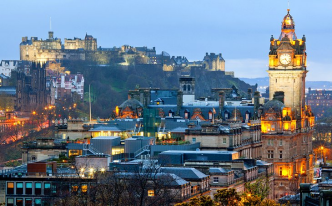
Scotland's most famous landmark, Edinburgh Castle is one of Britain's most visited tourist attractions. Highlights of a visit include hearing the famous One O'clock Salute from Half Moon Battery (cannon fire commemorates the tradition of helping ships synchronize their clocks), the impressive Scottish National War Memorial and National War Museum, and the stunning collection of Crown Jewels housed in the Royal Palace.
2. Palace of Holyroodhouse and Holyrood Abbey:
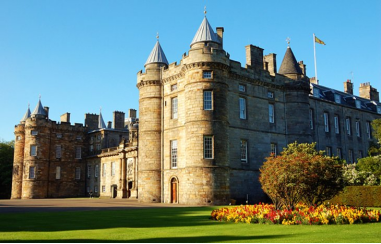
The Palace of Holyroodhouse — usually simply referred to as Holyrood Palace — is the Queen's official Edinburgh residence and has frequently been at the center of Scottish history. Built in 1678, it was where James II and James IV were each married, where James V and Charles I were crowned, and where "Bonnie Prince Charlie" held court in 1745.
3. The Royal Mile:
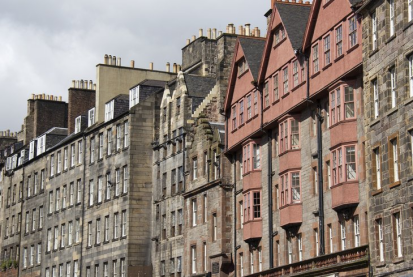
The Royal Mile refers to the streets linking Edinburgh Castle and the Palace of Holyroodhouse. Lined with charming townhouses, churches, and historic landmarks, this splendid thoroughfare is a great place to stroll for its shops (including kiltmakers), inns, museums, cafés, and restaurants.
Reference Website:
https://www.planetware.com/tourist-attractions-/edinburgh-sco-loth-edin.htm
VI. History
Early history
The earliest known human habitation in the Edinburgh area was at Cramond, where evidence was found of a Mesolithic camp site dated to c. 8500 BC. Traces of later Bronze Age and Iron Age settlements have been found on Castle Rock, Arthur's Seat, Craiglockhart Hill and the Pentland Hills.
When the Romans arrived in Lothian at the end of the 1st century AD, they found a Brittonic Celtic tribe whose name they recorded as the Votadini. The Votadini transitioned into the Gododdin kingdom in the Early Middle Ages, with Eidyn serving as one of the kingdom's districts. During this period, the Castle Rock site, thought to have been the stronghold of Din Eidyn, emerged as the kingdom's major centre. The medieval poem Y Gododdin describes a war band from across the Brittonic world who gathered in Eidyn before a fateful raid; this may describe a historical event around AD 600.
In 638, the Gododdin stronghold was besieged by forces loyal to King Oswald of Northumbria, and around this time control of Lothian passed to the Angles. Their influence continued for the next three centuries until around 950, when, during the reign of Indulf, son of Constantine II, the "burh" (fortress), named in the 10th-century Pictish Chronicle as oppidum Eden, was abandoned to the Scots. It thenceforth remained under their jurisdiction.
The royal burgh was founded by King David I in the early 12th century on land belonging to the Crown, though the date of its charter is unknown. The first documentary evidence of the medieval burgh is a royal charter, c. 1124–1127, by King David I granting a toft in burgo meo de Edenesburg to the Priory of Dunfermline. By the middle of the 14th century, the French chronicler Jean Froissart was describing it as the capital of Scotland (c. 1365), and James III (1451–88) referred to it in the 15th century as "the principal burgh of our kingdom".Despite the destruction caused by an English assault in 1544, the town slowly recovered, and was at the centre of events in the 16th-century Scottish Reformation and 17th-century Wars of the Covenant.
17th century
In 1603, King James VI of Scotland succeeded to the English throne, uniting the crowns of Scotland and England in a personal union known as the Union of the Crowns, though Scotland remained, in all other respects, a separate kingdom. In 1638, King Charles I's attempt to introduce Anglican church forms in Scotland encountered stiff Presbyterian opposition culminating in the conflicts of the Wars of the Three Kingdoms. Subsequent Scottish support for Charles Stuart's restoration to the throne of England resulted in Edinburgh's occupation by Oliver Cromwell's Commonwealth of England forces – the New Model Army – in 1650.
In the 17th century, Edinburgh's boundaries were still defined by the city's defensive town walls. As a result, the city's growing population was accommodated by increasing the height of the houses. Buildings of 11 storeys or more were common, and have been described as forerunners of the modern-day skyscraper. Most of these old structures were replaced by the predominantly Victorian buildings seen in today's Old Town.
18th century
Following the Treaty of Union in 1706, the Parliaments of England and Scotland passed Acts of Union in 1706 and 1707 respectively, uniting the two kingdoms in the Kingdom of Great Britain effective from 1 May 1707 As a consequence, the Parliament of Scotland merged with the Parliament of England to form the Parliament of Great Britain, which sat at Westminster in London. The Union was opposed by many Scots, resulting in riots in the city.
By the first half of the 18th century, Edinburgh was described as one of Europe's most densely populated, overcrowded and unsanitary towns. Visitors were struck by the fact that the various social classes shared the same urban space, even inhabiting the same tenement buildings; although here a form of social segregation did prevail, whereby shopkeepers and tradesmen tended to occupy the cheaper-to-rent cellars and garrets, while the more well-to-do professional classes occupied the more expensive middle storeys.
19th and 20th centuries
Although Edinburgh's traditional industries of printing, brewing and distilling continued to grow in the 19th century, and were joined by new rubber works and engineering works, there was little industrialisation compared with other cities in Britain. By 1821, Edinburgh had been overtaken by Glasgow as Scotland's largest city. The city centre between Princes Street and George Street became a major commercial and shopping district, a development partly stimulated by the arrival of railways in the 1840s. The Old Town became an increasingly dilapidated, overcrowded slum with high mortality rates. Improvements carried out under Lord Provost William Chambers in the 1860s began the transformation of the area into the predominantly Victorian Old Town seen today. More improvements followed in the early 20th century as a result of the work of Patrick Geddes, but relative economic stagnation during the two world wars and beyond saw the Old Town deteriorate further before major slum clearance in the 1960s and 1970s began to reverse the process. University building developments which transformed the George Square and Potterrow areas proved highly controversial.
VII. Culture
Festivals and celebrations
The city hosts a series of festivals that run between the end of July and early September each year. The best known of these events are the Edinburgh Festival Fringe, the Edinburgh International Festival, the Edinburgh Military Tattoo, the Edinburgh Art Festival and the Edinburgh International Book Festival.
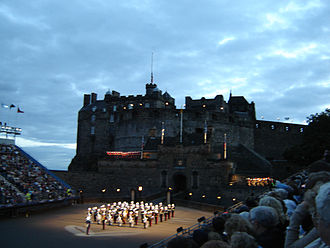
The longest established of these festivals is the Edinburgh International Festival, which was first held in 1947] and consists mainly of a programme of high-profile theatre productions and classical music performances, featuring international directors, conductors, theatre companies and orchestras.
This has since been overtaken in size by the Edinburgh Fringe which began as a programme of marginal acts alongside the "official" Festival and has become the world's largest performing arts festival. In 2017, nearly 3400 different shows were staged in 300 venues across the city. Comedy has become one of the mainstays of the Fringe, with numerous well-known comedians getting their first 'break' there, often by being chosen to receive the Edinburgh Comedy Award. The Edinburgh Military Tattoo, occupies the Castle Esplanade every night for three weeks each August, with massed pipe bands and military bands drawn from around the world. Performances end with a short fireworks display.
As well as the various summer festivals, many other festivals are held during the rest of the year, including the Edinburgh International Film Festival and Edinburgh International Science Festival.
The summer of 2020 was the first time in its 70-year history that the Edinburgh festival was not run, being cancelled due to the COVID-19 pandemic. This affected many of the tourist-focused businesses in Edinburgh which depend on the various festivals over summer to return an annual profit.
Music, theatre and film
Outside the Festival season, Edinburgh supports several theatres and production companies. The Royal Lyceum Theatre has its own company, while the King's Theatre, Edinburgh Festival Theatre and Edinburgh Playhouse stage large touring shows. The Traverse Theatre presents a more contemporary repertoire. Amateur theatre companies productions are staged at the Bedlam Theatre, Church Hill Theatre and King's Theatre among others.
The Usher Hall is Edinburgh's premier venue for classical music, as well as occasional popular music concerts. It was the venue for the Eurovision Song Contest 1972. Other halls staging music and theatre include The Hub, the Assembly Rooms and the Queen's Hall. The Scottish Chamber Orchestra is based in Edinburgh.
Museums, libraries and galleries
Edinburgh has many museums and libraries. These include the National Museum of Scotland, the National Library of Scotland, National War Museum, the Museum of Edinburgh, Surgeons' Hall Museum, the Writers' Museum, the Museum of Childhood and Dynamic Earth. The Museum on The Mound has exhibits on money and banking.]
Edinburgh Zoo, covering 82 acres (33 ha) on Corstorphine Hill, is the second most visited paid tourist attraction in Scotland,] and currently home to two giant pandas, Tian Tian and Yang Guang, on loan from the People's Republic of China.
Edinburgh is also home to The Royal Yacht Britannia, decommissioned in 1997 and now a five-star visitor attraction and evening events venue permanently berthed at Ocean Terminal.
Edinburgh contains Scotland's three National Galleries of Art as well as numerous smaller art galleries. The national collection is housed in the Scottish National Gallery, located on The Mound, comprising the linked National Gallery of Scotland building and the Royal Scottish Academy building. Contemporary collections are shown in the Scottish National Gallery of Modern Art which occupies a split site at Belford. The Scottish National Portrait Gallery on Queen Street focuses on portraits and photography.
VIII. Other information
Football
Men's
Edinburgh has three football clubs that play in the Scottish Professional Football League (SPFL): Heart of Midlothian, founded in 1874, Hibernian, founded in 1875 and Edinburgh City, founded in 1966.
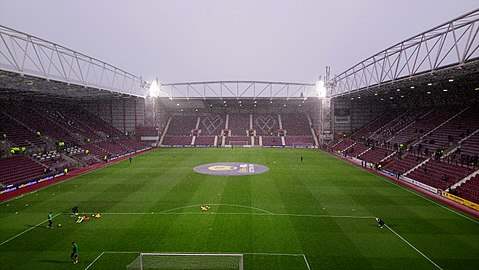
Heart of Midlothian and Hibernian are known locally as "Hearts" and "Hibs", respectively. The former plays in the Scottish Championship, the second-highest division of professional football in Scotland, while the latter plays in the top-level Scottish Premiership. They are the oldest city rivals in Scotland and the Edinburgh derby is one of the oldest derby matches in world football. Both clubs have won the Scottish league championship four times. Hearts have won the Scottish Cup eight times and the Scottish League Cup four times. Hibs have won the Scottish Cup and the Scottish League Cup three times each. Edinburgh City were promoted to Scottish League Two in the 2015–16 season, becoming the first club to win promotion to the SPFL via the pyramid system playoffs.
Edinburgh was also home to four other former Scottish Football League clubs: the original Edinburgh City (founded in 1928), Leith Athletic, Meadowbank Thistle and St Bernard's. Meadowbank Thistle played at Meadowbank Stadium until 1995, when the club moved to Livingston and became Livingston F.C. The Scottish national team has very occasionally played at Easter Road and Tynecastle, although its normal home stadium is Hampden Park in Glasgow. St Bernard's' New Logie Green was used to host the 1896 Scottish Cup Final, the only time the match has been played outside Glasgow.
The city also plays host to Lowland Football League clubs Civil Service Strollers, Edinburgh University and Spartans, as well as East of Scotland League clubs Craigroyston, Edinburgh United, Heriot-Watt University, Leith Athletic, Lothian Thistle Hutchison Vale, and Tynecastle.
Women's
In women's football, Hearts, Hibs and Spartans play in the SWPL 1. Hutchison Vale play in the SWPL 2.
Rugby
The Scotland national rugby union team and the professional Edinburgh Rugby team play at Murrayfield Stadium, which is owned by the Scottish Rugby Union and also used for other events, including music concerts. It is the largest capacity stadium in Scotland, seating 67,144 spectators. Edinburgh is also home to Scottish Premiership teams Boroughmuir RFC, Currie RFC, the Edinburgh Academicals, Heriot's Rugby Club and Watsonians RFC.
Rugby league is represented by the Edinburgh Eagles who play in the Rugby League Conference Scotland Division. Murrayfield Stadium has hosted the Magic Weekend where all Super League matches are played in the stadium over one weekend.
IX. Contact information
Mayor/Officer: Frank Ross
Tel: 0131 200 2324
Mail: socialcaredirect@edinburgh.gov.uk
Reference Website:
https://www.edinburghlordprovost.com/
https://www.edinburgh.gov.uk/contact
